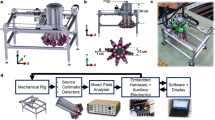Abstract
Corrosion under insulation (CUI) is a common cause of pipeline failure in the oil and gas industry. Its detection with conventional inspection techniques is challenging due to the presence of the insulation layer and a protective metallic cladding that prevent direct access to the pipe surface. Currently, several techniques are being developed to detect sections of wet insulation since water is a necessary precursor to corrosion. Among these, guided microwave testing (GMT) has been proposed as a cost-effective approach to screen an extended length of pipeline. The sensitivity of GMT is dependent on the strength of microwave reflections from wet volumes of insulation and has been demonstrated in the case of relatively abrupt transitions from dry to fully saturated insulation. This paper investigates the performance of GMT in the presence of saturation gradients characterizing more gradual transitions. Due to the lack of detailed field observations about realistic saturation paths, the paper proposes model experiments of saturation dynamics in a highly permeable material in a first attempt to determine saturation profiles resulting from capillary rise and seepage. The experimental observations reveal that the extent of the transition region is typically much smaller than the wavelength of the probing microwave signal and therefore has a limited effect on the amplitude of the reflected signal.













Similar content being viewed by others
References
Ifezue, D., Tobins, F., Nettikaden, V.: CUI failure of a hot oil line due to intermittent operations. J. Fail. Anal. Prev. 14(1), 13–16 (2014)
Edalati, K., Rastkhah, N., Kermani, A., Seiedi, M., Movafeghi, A.: The use of radiography for thickness measurement and corrosion monitoring in pipes. Int. J. Pres. Ves. Pip. 83(10), 736–741 (2006)
Cheng, W.: Pulsed eddy current testing of carbon steel pipes wall-thinning through insulation and cladding. J. Nondestruct. Eval. 31(3), 215–224 (2012)
Winnik, S.: Corrosion Under Insulation ( CUI) Guidelines. Elsevier, New York (2008)
Alleyne, D.N., Pavlakovic, B., Lowe, M.J.S., Cawley, P.: Rapid, long range inspection of chemical plant pipework using guided waves. Insight 43, 93–96, 101 (2001)
Mudge, P.: Field application of the teletest long range ultrasonic testing technique. Insight 43, 74–77 (2001)
Twomey, M.: Twomey, Inspection techniques for detecting corrosion under insulation. Mater. Eval. 55(2), 129–132 (1997)
Cho, H., Tamura, Y., Matsuo, T.: Monitoring of corrosion under insulations by acoustic emission and humidity measurement. J. Nondestruct. Eval. 30(2), 59–63 (2011)
Doe, R.: H2Obvious. http://www.h2obvious.com (2013). Accessed 1 May 2014
Jones, R.E., Simonetti, F., Lowe, M.J.S., Bradley, I.P.: Use of microwaves for the detection of water as a cause of corrosion under insulation. J. Nondestruct. Eval. 31(1), 65–76 (2012)
Jones, R.E., Simonetti, F., Lowe, M.J.S., Bradley, I.P.: The effect of bends on the long-range microwave inspection of thermally insulated pipelines for the detection of water. J. Nondestruct. Eval. 31(1), 117–127 (2012)
Lockington, D., Parlange, J.Y.: A new equation for macroscopic description of capillary rise in porous media. J. Colloid Interf. Sci. 278(2), 404–409 (2004)
Washburn, E.W.: The dynamics of capillary flow. Phys. Rev. 17(3), 273–283 (1921)
Hackett, F.E.: The rate of ascent of liquids through granular media. T. Faraday Soc. 17, 260–267 (1922)
Delker, T., Pengra, D.B., Wong, P.-Z.: Interface pinning and the dynamics of capillary rise in porous media. Phys. Rev. Lett. 76(16), 2902 (1996)
Lago, M., Araujo, M.: Capillary rise in porous media. Physica A 289(1), 1–17 (2001)
Waldron, R.A.: Theory of Guided Electromagnetic Waves. Van Nostrand Reinhold, London (1970)
Born, M., Wolf, E.: Principles of Optics: Electromagnetic Theory of Propagation, Interference and Diffraction of Light. Cambridge University Press, Cambridge (2001)
Jackson, J.D.: Classical Electrodynamics, 3rd edn. Wiley Publications Co., New York (1999)
Gabriel, C., Gabriel, S., Grant, E., Halstead, B., Mingos, D.: Dielectric parameters relevant to microwave dielectric heating. Chem. Soc. Rev. 27(3), 213–224 (1998)
Sharma, S., Patel, P.B., Patel, R.S., Vora, J.: Density and comparative refractive index study on mixing properties of binary liquid mixtures of eucalyptol with hydrocarbons at 303.15, 308.15 and 313.15 k. J. Chem. 4(3), 343–349 (2007)
Masbruch, K., Ferré, T.: A time domain transmission method for determining the dependence of the dielectric permittivity on volumetric water content. Vadose Zone J. 2(2), 186–192 (2003)
Tsui, F., Matthews, S.: Analytical modelling of the dielectric properties of concrete for subsurface radar applications. Constr. Build. Mater. 11(3), 149–161 (1997)
Brekhovskikh, L.: Waves in Layered Media Academic, 2nd edn. Academic Press, New York (1980)
Acknowledgments
The authors are grateful to Prof. Peter B. Nagy for many stimulating discussions and for suggesting the use of the input impedance method for the numerical simulations.
Author information
Authors and Affiliations
Corresponding author
Appendix: Simulation of Microwave Backscattering
Appendix: Simulation of Microwave Backscattering
In order to determine the reflection coefficient from an arbitrary refractive index profile \(n_{eff}(z)\) the transition length, \(\Delta \), is divided into \(N-1\) small equal intervals of length \(\delta =\Delta /(N-1)\) according to Fig. 14. It is then assumed that the refractive index of the kth element centered at position \(z=z_k\) is constant and equal to \(n_{eff}(z_k)\). Under this assumption the transition region can be considered as a layered medium and the reflection coefficient estimated using the input impedance method outlined in [24] for a plane wave incident on a planar system of layers. Letting \(Z_{in}^{(N)}\) be the input impedance of the system of \(N-1\) layers the reflection coefficient is given by the well known expression
where \(Z_{dry}\) is the impedance of dry insulation. The impedance \(Z_{in}^{(N)}\) is calculated from the impedances of each layer, \(Z_k\), given by
through the recursive formula
where \(v_k=\omega n_{eff}(z_k) /c\) is the wavenumber inside the \(k\)-th layer. To obtain \(Z_{in}^{(N)}\), formula (A3) is applied \(N-1\) times starting from layer 2 with the initialization condition \(Z_{in}^{(1)}=Z_1\).
Rights and permissions
About this article
Cite this article
Bejjavarapu, S.M., Simonetti, F. An Experimental Model for Guided Microwave Backscattering from Wet Insulation in Pipelines. J Nondestruct Eval 33, 583–596 (2014). https://doi.org/10.1007/s10921-014-0254-8
Received:
Accepted:
Published:
Issue Date:
DOI: https://doi.org/10.1007/s10921-014-0254-8





